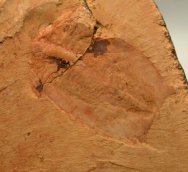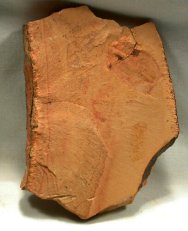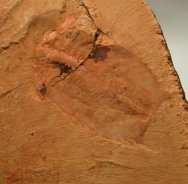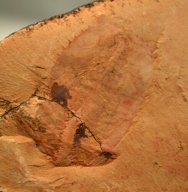|
 Description:
The exact taxonomic status of this arthropod is in dispute. It has
been termed a "trilobitomorph" by some researchers, showing
their beliefs in its close affinity with the trilobites. While the
Trilobitomorpha was listed in the Treatise, most now consider that
this subphylum is invalid, a catchall much like some of the dustbin
terms used by Walcott for a number of the Burgess Shale fauna. Whittington
termed Naraioa a "soft-bodied trilobite"' but that belief
is not supported at present. Their similarity in appearance to the
Agnoistida is purely a result of convergence. Two large groupings
of the Paleozoic arthropods are currently in favor: the Crustaceomorpha
(which includes Waptia) and the Arachnomorpha, dominated by the
trilobites. The Naraoiidae are arachnomorphs and include Misszhouia
and Naraoia. Description:
The exact taxonomic status of this arthropod is in dispute. It has
been termed a "trilobitomorph" by some researchers, showing
their beliefs in its close affinity with the trilobites. While the
Trilobitomorpha was listed in the Treatise, most now consider that
this subphylum is invalid, a catchall much like some of the dustbin
terms used by Walcott for a number of the Burgess Shale fauna. Whittington
termed Naraioa a "soft-bodied trilobite"' but that belief
is not supported at present. Their similarity in appearance to the
Agnoistida is purely a result of convergence. Two large groupings
of the Paleozoic arthropods are currently in favor: the Crustaceomorpha
(which includes Waptia) and the Arachnomorpha, dominated by the
trilobites. The Naraoiidae are arachnomorphs and include Misszhouia
and Naraoia.
The
species is one found in several locations within Yunnan Province,
but this one is from the most famous location of all, Maotianshan,
site of the discovery of the Chegjiang Biota by Hou Xian-guang in
1984. Indeed, it is this taxon which was first discovered at Maotianshan
to start the entire cycle of research.
The
diversity of soft-tissue fossils at Jengjiang is astonishing: algae,
medusiforms, sponges, priapulids, annelid-like worms, echinoderms,
arthropods (including trilobites), hemichordates, chordates, and
the first agnathan fish make up just a small fraction of the total.
Numerous problematic forms are known as well, some of which may
have represented failed attempts at diversity that did not persist
to the present day.
This
specimen shows many of the classic features of the taxon. Even the
diagnostic spines that give the species its name and the central
gut are evidence, as is the soft cuticle that betrays the outline
of the body.
|



